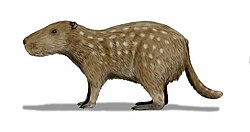| Ctenodactylomorphi | |
|---|---|
 | |
| Ctenodactylus gundi | |
| Scientific classification | |
| Domain: | Eukaryota |
| Kingdom: | Animalia |
| Phylum: | Chordata |
| Class: | Mammalia |
| Order: | Rodentia |
| Suborder: | Hystricomorpha |
| Infraorder: | Ctenodactylomorphi Chaline and Mein, 1979 |
Ctenodactylomorphi is an infraorder of the rodent suborder Hystricomorpha that includes two living families, the Ctenodactylidae (gundis) [1] and the Diatomyidae (Laotian rock rat). [2]














